

SAMPLER BOOK
Course Features
● New design and illustration
● New animated comics and stories
● New projects, crafts, and games
● New grammar and writing practice
● Enhanced CLIL activities
● Enhanced songs and chants
● Free downloadable teacher’s resources
Meet the Kemp Family

STUDENT BOOK


























































































































































Additional practice of vocabulary set 2, speaking, and grammar activities
























Starter Scope and Sequence
• Things for school
• Asking and answering about what something is
• Members of a family
• Talking about your family and their appearances
• Toys and gifts
• Asking and answering about what something is
School: backpack, book, chair, classroom, crayon, desk, eraser, paper, pen, pencil, ruler, school
Family and friends: brother, dad, family, friend, mom, sister
Appearance: big, old, short, small, tall, young
Toys and gifts: ball, balloons, boat, box, car, dolls, gift, planes, robots, top, toy, trains
Shapes and Colors
• Shapes and colors
• Talking about what shape or color something is
• Things at the playground
• Talking about locations
• Face and body part
• Talking times and days
• Fruits and snack foods
• Talking about what you like or want to eat
• Actions and sports
• Talking about things you can or can’t do
• Animals at the zoo
• Talking about what you see at the zoo
• Times of the day
• Telling times and days
Shapes: circle, rectangle, shape, square, star, triangle
Colors: brown, color, green, pink, red, white
Playground things: flower, jungle gym, playground, sandbox, seesaw, slide, swing, tree, wall
Prepositions of place: in, near, on
Face: ear, eye, face, mouth, nose, tooth Body: arm, body, foot, hand, leg, neck
Fruits: apple, banana, fruit, grapes, orange, pear Snack foods: burger, cookie, fries, ice cream, potato, pizza
Actions: catch, jump, play, run, swim, throw
Sports: badminton, baseball, basketball, hockey, soccer, tennis
Animals: crocodile, elephant, frog, giraffe, goat, hippo, lion, lizard, monkey, tiger, turtle, zebra
Time: breakfast, lunch, dinner, time, eleven, twelve
Days of the Week: Monday, Tuesday, Wednesday, Thursday, Friday, Saturday, Sunday
WELCOME
Characters: Ben, Emma, Jenny, Nick, Snowball, Peanut
Greetings: Good morning, Good afternoon, Good evening
Numbers: 1 to 10
Alphabet: Aa to Zz

Structures CLIL Phonics Project
• Demonstrative pronouns (this, that) What is this? This is my pencil.
• Possessive adjectives This is my crayon. / That is your backpack.
• Subject pronouns (he, she) He is tall. / She is small.
• Simple present (be) with yes/no questions Is he tall? Yes, he is. / No, he isn’t.
• Simple present (be) with information questions Who is he? He is my dad.
• Simple present (be) with yes/no questions Is it a top? Yes, it is. / No, it isn’t. (It's a boat.)
• Singular and plural nouns It’s a balloon. / They are cars.
• Subject pronouns (it, they) Is it a balloon? / Are they cars?
• Simple present (be) with information questions What shape is it? It’s a square. What color is it? It is yellow.
• Let’s... Let’s draw a picture!
• Simple present (be) with information questions What is it? It’s a swing.
• Simple present with prepositions of place (at, in, on, near) Where is Emma? She’s on the jungle gym.
• Simple present (have) and expressing agreement I have a nose. So do I! / She has two eyes. So do I!
• Simple present (have) with information questions How many hands does he have? He has two hands.
• Simple present (like) with yes/no questions Do you like apples? Yes, I like apples. / No, I don’t like apples.
• Simple present (want) with information questions (a, an, some) What do you want? I want some fries.
• Can for ability with yes/no questions
Can you jump? Yes, I can. / No, I can’t.
• Let’s for suggestions Let’s play soccer. OK. That sounds good. / No, I can’t play.
• Simple present (see) with information questions What do you see? I see a goat.
• Simple present (see) with yes/no questions Do you see two lions? Yes, I do. / No, I don’t. I see one lion.
• Simple present (be) with information questions What time is it? It’s two o’clock.
• Simple present (be) with information questions What day is it? It’s Monday.
Social Studies: I Like School!
Social Studies: I Love My Brother!
Aa–Cc
Aa: apple, ant
Bb: ball, bear Cc: car, cat
Dd–Ff
Dd: duck, door
Ee: elephant, egg Ff: frog, fish
Social Studies: Look at My Room Gg–Ii
Gg: goat, gorilla
Hh: hippo, hat Ii: iguana, igloo
Science: Cloud Shapes
Social Studies: At the Playground
Science: I Love My Body!
Social Studies: Please and Thank You
Jj–Ll
Jj: jump, jet
Kk: king, kite Ll: lion, lemon
Mm–Oo
Mm: mom, mouse
Nn: nine, nut Oo: ox, ostrich
Pp–Rr
Pp: pen, panda
Qq: queen, quilt
Rr: robot, ring
Ss–Uu
Ss: sister, sun
Tt: ten, tiger
Uu: up, umbrella
Physical Education: PE Class Vv–Xx
Vv: vest, van
Ww: window, water
Xx: ox, box
Science: What Animals Eat Yy–Zz
Playground
Yy: yak, yellow Zz: zebra, zoo The Zoo
Social Studies: What Time Is It? Phonics Review
Book 1 Scope and Sequence
• Things for school
• Saying what you have and what you don't have
School things: backpack, crayon, eraser, glue stick, lunchbox, marker, notebook, paintbrush, pen, pencil, pencil case, pencil sharpener, ruler, stapler, tape, textbook 2 My Toys
School Things
• Toys and playthings
• Saying who something belongs to
Toys and playthings: airplane, baseball glove, bike, blocks, board game, cards, doll, elephant, hula hoop, jump rope, kite, puzzle, rollerblades, skateboard, soccer ball, video game 3
My Classroom
• Things in a classroom
• Saying what color something is
Classroom objects: bookcase, calendar, chair, clock, computer, cupboard, desk, drawer, drawing, easel, map, mat, poster, shelf, wastebasket, whiteboard 4 Family and Friends
• Members of a family
• Talking about someone's age
Actions
• Describing common actions happening at the moment
• Names of animals
• Describing feelings
• Talking about what someone is doing at the moment
• Telling where people are in a house
• Describing how someone or something looks
• Saying what people do and where they work
• Everyday activities
• Talking about your abilities
Family members and relationships: aunt, brother, children, cousin, family, father (dad), friend, grandfather (grandpa), grandmother (grandma), grandparents, mother (mom), neighbor, parents, sister, teacher, uncle
Actions: drink, eat, fly, jump, run, sleep, swim, walk
Animals: bird, cow, fish, horse, mouse, rabbit, sheep, snake
Feelings and sensations: angry, bored, cold, excited, happy, hot, hungry, relaxed, sad, scared, sick, surprised, thirsty, tired, upset, worried
Activities: eat, exercise, listen to music, play soccer, read, study, use the computer, watch TV
Locations around the house: backyard, bathroom, bedroom, dining room, garage, hall, kitchen, living room
Face and body: arm, ear, eye, face, foot, hair, hand, head, leg, mouth, nose, tooth Hair: curly hair, long hair, short hair, straight hair
Jobs: actor, businessman, cook, doctor, farmer, florist, pilot, police officer
Workplaces: airport, farm, flower shop, hospital, office, police station, restaurant, theater
Abilities: bake a cake, cook, draw pictures, drive a car, fix, fly a kite, juggle, jump, play the guitar, ride a bike, sew, sing, skate, ski, speak English, surf
WELCOME
Characters: Steven, Clare, Alex, Brian, Emma
Colors: pink, green, blue, yellow, black, orange, red, purple
Numbers: 1 to 20
Shapes: square, circle, triangle, diamond, rectangle

Structures CLIL Phonics Project
• Singular and plural nouns I have one pen. I have five pens.
• Simple present (have) with yes/no questions Do you have a stapler? Yes, I do. / No, I don’t. I don’t have a stapler.
• Simple present (have) with information questions What do you have in your pencil case? I have one pencil / two pencils.
• Simple present (be) with subject complements What is it? It is a doll.
• Possessive adjectives (my, your) They’re my rollerblades. / They’re your rollerblades.
• It/They It is a doll. / They are rollerblades.
• Demonstrative pronouns (this, these, that, those) That is a whiteboard. / Those are posters.
• Simple present (be) with subject complements What is that? That is a computer.
• Adjectives as complements The clock is red.
• Simple present (be) with yes/no questions Is she your mother? Yes, she is. / No, she isn’t.
• Pronouns (he, she, they) Is she your mother? / Are they your parents?
• Numbers She is 10 years old.
• Present progressive with information questions What is he doing? He is drinking.
• Present progressive with yes/no questions Are the birds flying? Yes, they are. / No, they aren’t.
• Simple present (be) with adjective complements How are you? I’m happy.
• Simple present (be) with yes/no questions Are you excited? Yes, I am. / No, I’m not.
• Present progressive What is Emma doing? She is playing soccer.
• Simple present (be) with prepositions of location (in) Where is Liz? She’s in the living room.
• Simple present (have) with information questions What does he look like? He has blond hair and blue eyes.
• Simple present (have) with yes/no questions Does she have long hair? Yes, she does. / No, she doesn’t.
• Simple present (be) with subject questions What do they do? They’re cooks.
• Simple present with prepositions of place (at, in, on) Where does she work? She works at a flower shop.
• Can and can’t for ability with information questions What can Clare do? She can ride a bike. She can’t swim.
• Can and can’t with yes/no questions Can he sew? Yes, he can. / No, he can’t.
Social Studies: Different Kinds of Families
Soft c: bicycle, celery, cell phone, city Hard c: Canada, car, color, computer, cupboard
Health: Active Kids Long a: bay, day, rain, skates, snake, table, train Animal Spinners
Social Studies: How Do You Feel?
Science: Robots and Computers
Science: The Animal Kingdom
Social Studies: Where Do Vegetables Come From?
Science: Amazing Lions
y (long e): angry, baby, happy, hungry, silly, thirsty y (long i): cry, dry, fly, fry, sky, why My Happy Heart
Long i: bike, dining room, exercise, kite, light, pie My House
Soft g: Egypt, gel, gem, giraffe, gym Hard g: gas, gate, gold, golf, gum
s-blends: sk: ski, sky; sp: speak, spoons; st: stairs, stapler; sl: sleep, slide
s-blends: sm: small, smell, smile; sn: snack, snake, snow; sw: swan, swim
Paper Plate Face
Job Paper Doll Chain
Animal Mask
Book 2 Scope and Sequence
• Food items
1 Snack Time
2 My Clothes
3 My Favorite Food
4 My Classes
5 Finding Things
• Saying what you like and don’t like
• Clothing and jewelry
• Describing what someone is wearing
• Offering and asking for something to eat or drink
• Asking how something looks, smells, or tastes
• Talking about what classes you have
• Asking if someone has things for school
• Explaining where something is around the house
• Asking about the location of something
Food: apples, bananas, candy, cereal, chocolate, cookies, fries, fruit, milk, popcorn, rice, soda, soup, tomatoes, vegetables, yogurt
Clothing: boots, coat, dress, glasses, hat, jacket, jeans, pajamas, pants, ring, shirt, shoes, skirt, sweatshirt, T-shirt, watch
Food: bread, cake, cheese, chips, fish, ice cream, juice, lemonade, meat, pasta, pizza, salad
Describing food: bad, good, sour, sweet
School subjects: art, computers, English, geography, gym, math, music, science
Things for school: calculator, dictionary, folder, map, paper, recorder, scissors, shorts
In the bathroom: comb, counter, shower, sink, soap, toilet, toothbrush, towel
Outdoors: ball, bucket, bush, porch, rope, shovel, swing set, yard 6 It’s Hot!
• Weather conditions and things to wear outside
• Telling someone what to do or not do
• Seasonal activities
• Asking about what time of year people usually do things
• Things around the house
• Describing what is in the rooms of a house
• Things in nature
• Talking about what was in a place
• Buying things in a store
• Talking about how much something costs
Weather: cloudy, cold, dry, foggy, hot, sunny, wet, windy
Things to wear outside: baseball cap, pants, raincoat, scarf, snowsuit, sunglasses, sunscreen, sweater
Seasonal activities: clean the house, eat ice cream, go camping, go for a walk, go skating, go sledding, go to the beach, make a sandcastle, make a snowman, pick apples, plant flowers, play baseball, play tennis, rake leaves, start school, throw snowballs
Things around the house: bed, bookcase, chair, door, dresser, lamp, mirror, picture, plant, rug, sofa, stereo, stove, table, television, window
Things in nature: beach, forest, grass, hill, island, lake, mountain, tree
Adjectives: boring, clean, dirty, exciting, high, low, old, tall
Stores: bakery, bookstore, candy store, clothing store, ice cream parlor, pet store, shoe store, toy store
Things to buy: bookmark, cat toy, donut, ice cream cone, lollipop, sneakers, teddy bear, vest
WELCOME
Characters: Steven, Clare, Alex, Brian, Emma
Days of the week: Monday, Tuesday, Wednesday, Thursday, Friday, Saturday, Sunday
Months: January, February, March, April, May, June, July, August, September, October, November, December
Seasons: spring, summer, fall, winter

Structures CLIL Phonics Project
• Simple present in positive and negative statements I like chocolate. / I don’t like cookies.
• Simple present with so and neither He likes rice. So do I. / He doesn’t like rice. Neither do I.
• Present progressive to describe what someone is wearing What is she wearing? / She’s wearing a green skirt.
• Present progressive with yes/no questions Is he wearing glasses? Yes, he is. / No, he isn’t.
• Simple present to express what someone wants What do you want? I want salad, please.
• Simple present (linking verbs) with yes/no questions Does the pasta look/smell/taste good? Yes, it does. / No, it doesn’t.
• Simple present to say what classes someone has What does she have on Tuesday? / She has music on Thursday.
• Simple present (have) with yes/no questions Do you have paper? Yes, I do. / No, I don’t.
• Prepositions of place (on, in, under) The towels are on the counter. / The soap is not under the sink.
• Prepositions of place (on, in, under) with yes/no questions Are the buckets in the bush? Yes, they are. / No, they aren’t. They’re on the bush.
• Simple present (be) to ask and answer about the weather How’s the weather? It’s sunny.
• Simple present (be) with yes/no questions Is it sunny? Yes, it is. / No, it isn’t.
• Imperatives: positive and negative Put on your sunglasses. Don’t put on your baseball cap.
• Simple present to talk about habitual actions at a certain time of the year
What does he do in the summer? / He picks apples in the summer.
• Simple present to talk about habitual actions with yes/no questions Do we rake leaves in the spring? Yes, we do. / No, we don’t.
• Simple present with there to describe what is in a place There is a sofa. / There are two sofas.
• Simple present questions with where and prepositions of place (behind, in front of, next to, on) Where is the stereo? It’s on the dresser.
• Simple past with there to describe what was in a place There was a beach. / There were some mountains.
• Questions with How was/were to describe natural features How was the forest? It was quiet. How were the mountains? They were exciting.
• Can for ability with questions ( Where) Where can I buy a teddy bear? You can buy it at the toy store.
• Simple present with information questions How much is it? / How much are they? It costs... / They cost...
Science: How Does Fruit Grow?
r-blends: br: breakfast, brothers; dr: drawer, drawing; fr: friends, frog; gr: grandparents, grapes; pr: princess
Social Studies: Hats Matter n-blends: nd: hand, wand; ng: ring, sing; nk: bank, drink; nt: paint, pants
History: The History of Pizza Digraphs: ch: chairs, cheese, chips, lunch box; sh: dishes, sheep; th: thirsty, thumb
Social Studies: Inside My Backpack s-sh distinction: s: science, scissors, sisters, soccer; sh: English, fish, shoes, shorts Flash Cards
Science: Ant Colonies
r-l distinction: l: fly, lake, lights, toilet; r: fries, rake, right, rope
Geography: Hot and Cold Deserts
l-blends: bl: black, blue; cl: clock, cloudy; fl: flag, snowflake; gl: gloves, sunglasses; sl: slippers
Geography: The USA: A Place For Every Season
ing sound: camping, ring, running, shopping, sing, skating, spring, swing
Season Tree
Social Studies: A Mongolian House s-st distinction: s: say, soccer ball, sore; st: stay, stereo, store, stove My House Mini-book
Geography: Sequoia National Park ch digraph: beach, chair, cheese, chips, chocolate, lunch, sandwich, teach 3-D Mountain
Math: How Much Is It?
hard th: brothers, father, these, they, this, weather soft th: math, month, thank, theater, toothpaste, three
Model Town
Book 3 Scope and Sequence
• Telling time
1 A Day in My Life
2 Transportation
3
Last Week at School
4 What Are They Doing?
5 In the Kitchen
6 Festivals
• Talking about daily activities
• Vehicles
• Talking about ways of traveling
• Places around a school
• Talking about what happened at school
• Common actions
• Talking about what someone is doing now
• Names of foods
• Talking about what there is or isn’t in the kitchen
• Activities at a festival
• Talking about what people did at a festival
• Sports
• Talking about what you are good at
Routine activities: brush my teeth, change into pajamas, comb my hair, do homework, eat a snack, eat breakfast, get dressed, go home, go shopping, go to sleep, make my bed, practice the piano, put on shoes, take a bath, wake up, wash my face
Vehicles: boat, helicopter, metro, motorcycle, plane, school bus, taxi, tram
Actions: on foot, ride, take
Locations: airport, hotel, museum, port, station
School activities: carry a backpack, finish a book, listen to music, paint, play, study, wait, walk
Places in a school: bus stop, cafeteria, classroom, field, gym, hallway, library, playground
Common actions: answer, close, cut, enter, give, glue, help, laugh, look for, pack, practice, rest, show, stand, take a picture, teach
Food: burger, butter, chicken, egg, jam, lemon, muffin, oil, omelet, onion, peanut butter, pepper, salt, strawberry, toast, water
Irregular verbs: eat, blow up balloons, drink, make snacks, run around, sing, swim, wear costumes
Festival activities: clean up, color pictures, dance, listen to music, open presents, play games, talk to friends, watch a parade 7 I Love Sports!
Sports actions/activities: catch the ball, dive, do push-ups, jog, jump rope, kick the ball, lift weights, pass the ball, score a goal, serve the ball, shoot baskets, throw a ball, use a racket
Adverbs: far, fast, high 8 Likes and Dislikes
• Hobbies and fun activities
• Talking about what you like and don’t like
• Healthy and unhealthy habits
Health and Habits
Going to the Doctor
• Talking about how often you do something and giving advice
• Health problems
• Talking about what happened
Indoor games and activities: board game, cards, chess, music, ping pong, pool, video game
Outdoor activities: climbing trees, football, hiking, ice skating, mountain biking, skateboarding, skiing, snowboarding, surfing
Healthy and unhealthy habits: brush my teeth, drink soft drinks, drink water, eat candy, eat fast food, eat fruits and vegetables, get a checkup, get exercise, get fresh air, play video games, stay up late, take a rest, take a shower, wake up early, wash my face, wash your hands
Ailments: break my arm, catch a cold, get a bruise, get a burn, get a cramp, get a cut, get a sore throat, get a toothache, get an earache, get dizzy, have a cough, have a fever, have a headache, have a runny nose, have a stomachache, hurt my foot
WELCOME
Characters: Steven, Clare, Alex, Brian, Emma
Telling time
Ordinal numbers: 1st-31st
Dates

Structures Writing CLIL Project
• Simple present with information questions about time What time does she wake up? She wakes up at six o’clock.
• Simple present (be) with questions about time What time is it? It’s three o’clock. It’s time to eat a snack.
• Simple present with information questions How do you go to school? I go to school by bus.
• The modal verb can with information questions How can you get to work? I can take a train.
• Simple past (regular verbs) with information questions What did she do? She listened to music.
• Simple past (regular verbs) with yes/no questions Did you play in the gym? Yes, I did. / No, I didn’t.
• Present progressive with information questions What is Brian doing? He is taking a picture.
• Present progressive with yes/no questions Are they laughing? Yes, they are. / No, they aren’t.
• Some and any with countable and uncountable nouns (do + have) Do they have any jam? Yes, they have some jam. / No, they don’t have any jam.
• Some and any with countable and uncountable nouns (be + there) Are there any snacks? Yes, there are some snacks. / No, there aren’t any snacks.
• Simple past (irregular verbs) with information questions What did he do? He drank juice.
• Simple past (regular verbs) with yes/no questions Did she sing? Yes, she did. / No, she didn’t. The Festival Social Studies: Traditions Around the World Poster
• Simple present with be good at + gerund Steve is good at shooting baskets.
• Can for ability with adverbs I can throw the ball far. / She can throw the ball far.
• Simple present with love, like, don’t like, or hate + gerund I love playing football.
• Simple present yes/no questions with like + gerund Does he like hiking? Yes, he does. / No, he doesn’t.
• Simple present with how often questions and adverbs of frequency How often does Brian wash his face? He always washes his face.
• Should and shouldn’t for advice You should eat fruit and vegetables.
• Simple past with information questions What happened? I broke my arm.
• Past progressive with information questions What happened? I was riding my bike and I broke my arm.
Book 4 Scope and Sequence
Unit Title
1 Lots to Do
2 Follow the Rules
3 The Natural World
4 Amazing Safari Animals
5 Describing People
Learning Points
• Places around town
• Talking about activities one has to do
• Rules in public places
• Saying what you must or must not do and what you may or may not do
6 Directions
• Enjoying the natural world
• Comparing activities, transportation, and locations
• Safari animals
• Comparing animals using adjectives and adverbs
• Personality traits
• Describing people
• Places in a town
• Asking for and giving simple directions
Vocabulary
Things to do: buy groceries, get a haircut, get medicine, get tickets, look for a book, mail a letter, pay a bill, return clothes
Places around the neighborhood: bank, bookstore, department store, hairdresser, pharmacy, post office, supermarket, theater
Activities at a library: bring a library card, listen to the librarian, return books on time, shout, sit on a desk, take photos, turn off the phone, wear headphones
Activities at a museum: bring my bag inside, chew gum, climb on the sculptures, have food and drinks, sketch pictures, take notes, touch the art, use a video camera
Adjectives: amazing, comfortable, dangerous, enjoyable
Activities in nature: fly in a jet, go cliff diving, go snorkeling, go whale watching, go windsurfing, ride a ferry, stay at a campsite, stay at a resort, take a cab, take public transportation, visit ruins, watch lightning
Safari animals: buffalo, cheetah, giraffe, hippo, lion, monkey, rhino, tiger
Adjectives: hairy, heavy, short, strong
Adverbs: noisily, quickly, silently, slowly
Personality: adventurous, annoying, brave, calm, confident, easygoing, greedy, hardworking, honest, impatient, nervous, proud, selfish, sensible, silly, unfriendly
Places in a town: bakery, coffee shop, convenience store, corner, crosswalk, fire station, gas station, market, park, shoe store, town square, traffic light, train station
Directions: go straight, turn left, turn right 7 Getting Around Town
• Transportation
• Asking what time something happens and how long something takes
• Free-time activities
• Talking about weekly routines
8 My Free-time Activities
Transportation: bicycle, bus, ferry, motorcyle, on foot, subway, taxi, train, truck, van
Places: cafe, ticket office
Verbs: arrive, close, leave, open
Free-time activities: chat online, do martial arts, go cycling, go diving, go for a walk, go ice skating, go to a comic book store, go to the drama club, go to the playground, play basketball, play volleyball, see friends, surf the net, take guitar lessons, watch quiz shows, work on the garden 9 A Wonderful Vacation!
• Vacation and leisure activities
• Talking about future plans
Vacation activities: build a sandcastle, buy souvenirs, fly on an airplane, go fishing, go on a cruise, go surfing, go to an amusement park, play in a swimming pool, relax on the beach, sail on a boat, stay at a hotel, swim in the ocean, take a tour, visit a castle, visit a museum, watch a musical 10 Let’s Cook!
• Cooking words and ingredients
• Giving instructions
Ingredients: beef, broccoli, flour, parsley, sauce, sugar
Ways of cooking: boil, chop, fry, heat, mix, pour, stir, whisk Things in a kitchen: bowl, oven
WELCOME
Characters: Alex, Daniel, Jenny, Li, Mateo, Nadir
Time, countries, and nationalities
Prepositions of time

Structures CLIL Project
• Have / Has to for obligation
She has to mail a letter.
• Have to with yes/no questions Do you have to go to the bookstore? Yes, I do. / No, I don’t.
• Must / Must not for obligation You must return books on time. / You must not sit on the desks.
• May / Can to request permission May I take notes? Yes, you may. / No, you may not. Can I use my phone? Yes, you can. / No, you can’t.
• Comparative with more + long adjectives Taking a cab is more comfortable than taking public transportation.
• Comparatives with as as and not as as Watching lightning is as amazing as visiting ruins.
• Comparatives with adjectives A monkey is shorter than a giraffe.
• Comparatives with adverbs A hippo moves more slowly than a cheetah.
• Adjectives with adverbs of frequency to describe personality She is always hardworking.
• Superlatives with adjectives She is the most adventurous. He is the greediest.
• Prepositions of place to describe locations in a town The bakery is between the market and the town square.
• Imperatives to give directions Go straight and turn left.
• What time + simple present to ask when regular things happen What time does the café open? It opens at 9 a.m.
• How long + simple present to ask how long something takes How long does it take to get to the supermarket by taxi? It takes about five minutes.
• What do + simple present to ask about regular activities What do you do every Monday / on Mondays? I take guitar lessons.
• Questions of frequency and time How often do you play basketball? I play basketball twice a week.
• Will and be going to to talk about the future I am going to buy souvenirs. We will visit a museum.
• Might for future possibility He might go fishing tonight.
• Imperatives for giving instructions (with transition words) First, heat the oven.
• Negative imperatives
Don’t chop too much parsley.
Social Studies: Magnificent Malls Role-play
Social Studies: Rules Around the World Poster
Social Studies: World Heritage Sites Role-play
Science: Migrating African Animals Poster
Social Studies: Outward Bound Survey
Geography: The Life of a European Student Role-play
Social Studies: Transportation Around the World Survey
Social Studies: Summertime in Russia Survey
Social Studies: The Tomatina Poster
Social Studies: Cakes From Around the World Poster
Book 5 Scope and Sequence
• Activities and chores
• Discussing future plans
Future Plans
2
Thinking About the Past
3
4
Getting a Pet
• Old technology
• Talking about past activities and habits
• Kinds of pets
• Talking about preferences
• Household chores
• Talking about recently completed chores
Helping at Home
• School sports events
• Talking about experiences
Activities and chores: blog, check my homework, do housework, go for a run, go to gymnastics, go to the bike shop, go to the dentist, go to the mall, go to the recycling center, golf, help out a friend, organize my desk, purchase books, repair my glasses, type a paper, watch the soccer game
Activities from the past: collect stamps, deliver newspapers, develop photos, keep an address book, play cassette tapes, record videos, use payphones, watch silent films
Childhood activities: catch butterflies, crawl, cry a lot, fall down, feed your siblings, have a babysitter, name toys, take naps
Pets: goldfish, hamster, kitten, lizard, parrot, rabbit, snake, turtle
Adjectives: active, clever, cute, easy to care for, friendly, playful, quiet, soft
Household chores: clean the bathroom, clean the windows, clean your room, cut the grass, do the dishes, dust the furniture, feed the cat, fold the laundry, mop the floor, pick up the toys, set the table, sweep the floor, take out the trash, vacuum the carpet, water the plants, weed the garden 5 A School Competition
• Environmental issues
• Talking about problems and solutions
Environment
• Weather words and indoor/outdoor activities
• Saying what you will do in different types of weather
• Actions at a sports game
• Talking about events at a specific time in the past
• Things sold in stores and markets
• Talking about where items are from
• Community service activities
• Reporting what someone said
Actions at sports events: do the high jump, do the long jump, lose an event, run a marathon, run the hurdles, take part in a competition, tie a race, win a prize
Sports events: badminton, field hockey, handball, javelin, pole vault, relay, rugby, shot put
Problems: clean air, endangered animal, garbage, green areas, noise, pollution, traffic jam, trash cans
Solutions: hold a town hall meeting, pick up garbage, plant trees, recycle, ride bikes, start a campaign, take public transportation, write a letter
Weather: boiling, chilly, cool, freezing, rainy, snowy, stormy, sunny
Indoor/Outdoor activities: do homework, go on a picnic, go swimming, go to the park, play in the yard, play on the tablet, practice the guitar, visit the library
Actions at sports games: blow the whistle, celebrate, cheer, clap, discuss a plan, do an interview, film the game, receive a trophy, scream, slip, take a break, warm up
People: coach, crowd, player, referee
Store merchandise: candle, coconut, curtains, digital camera, flute, PC, pineapple, salmon, sandals, skis, smartphone, souvenir, suitcase, trumpet, umbrella, uniform
Community service activities: carry bags, change a tire, clean up beaches, collect money, donate clothes, fix a computer, give advice, help the homeless, hold bake sales, lend a textbook, organize food drives, put up a picture, shovel snow, visit elderly people, volunteer at an animal shelter, wash a car
WELCOME
Characters: Alex, Daniel, Jenny, Li, Mateo, Nadir
Personal information: country, birthday, personality, hobby
Structures
• Present progressive with future meaning What are you doing tomorrow? I’m doing housework.
• Need to for obligation I need to purchase some books.
• Used to to describe past habits and actions She used to record videos when she was younger.
• Yes/No questions with use to Did you use to cry a lot when you were younger? Yes, I used to cry a lot. / No, I didn’t use to cry a lot.
• Would rather for preference I would rather get a puppy than a rabbit.

Writing CLIL Project
Descriptive Paragraph (Review) Physical
Life On a Soccer Team
Expository Essay History: Listening to Music in the Past
• Prefer and over for preference I would prefer a turtle over a lizard. Comparison Essay
• Present perfect with yet and already to ask if someone has done something Have you set the table yet? Yes, I’ve already done it. / No, I haven’t done it yet.
• Present perfect with yet and already to ask if anyone has done something Has anyone cut the grass yet? Yes, Mateo has already done it. / No, no one has done it yet.
• Present perfect to talk about past experiences I have taken part in a competition. / I have never won a prize.
• Have you ever to ask about past experiences
Have you ever played field hockey? Yes, I have played field hockey twice. / No, I have never played field hockey.
• Too much, too many, and not enough with countable and uncountable nouns
There is too much pollution. / There are too many traffic jams. / There are not enough garbage cans.
• Can/Could to make suggestions We could ride bikes. We can recycle.
• First conditional If it’s sunny this weekend, I’ll play in the yard.
• Yes/No questions with first conditional Will you go swimming if it’s boiling? Yes, I will. / No, I won’t.
• Past progressive to talk about actions at a specific time He was filming the game at 2:30 p.m.
• Past progressive with when to talk about interruptions The crowd was clapping when the player slipped.
• Passive voice to talk about the origin of products The sandals are made in Brazil.
• Tag questions (passive voice)
That suitcase is made in Italy, isn’t it? Yes, it is. / No, it isn’t.
• Reported speech (simple present – simple past) I donate clothes. She said that she donated clothes.
• Reported speech (simple past – past perfect) I fixed a computer last week. He said that he had fixed a computer last week.
Studies: Working Animals
Process Essay History: Doing the Laundry 100 Years Ago
Opinion Essay History: The World's Oldest Competition
Argumentative Essay
Helping Endangered Species
Cause and Effect Essay
Narrative
Geography: Summer in New Delhi
Classification Essay History: The Silk Road
Problem/Solution Essay Social Studies: Learning About Communities
Book 6 Scope and Sequence
Title Learning Points Vocabulary
1 Give It a Try!
2 An AccidentFilled Day
3 Great Ideas From the Past
4 You Should Have...
• New activities
• New environments
• Talking about trying new things
• Mishaps and annoyances
• Talking about activities in the past and recent past
• Inventions, discoveries, and famous structures
• Talking about past events in history
• Giving advice
• Regrets about bad behavior
• Talking about going on a tour
• Talking about overtourism issues
5 Being a Tourist
• Guessing situations and people’s thoughts
• Making deductions
Activities: act in a play, code, create a playlist, design a website, do karate, edit a video, go to a concert, join a club, learn a language, learn photography, paint a mural, play an instrument, record a podcast, support a team, take a first aid course, try a new recipe
Accidents: break, drop, find, knock over, lose, smash, spill, trip
Habits and routines: be a fan of, have a broken arm/leg, have a pet, know your best friend, play lacrosse, play the violin, study English, work on a project
Inventions: cement, compass, elevator, light bulb, microscope, seat belt, telephone, thermometer
Discoveries: gravity, oxygen, Pluto, x-ray
Structures: Eiffel Tower, Empire State Building, Golden Gate Bridge, Taj Mahal
Actions: ask for permission, be grounded, be punished, be respectful, cheat on a test, copy someone’s homework, fail an exam, feel guilty, fight, get detention, get good, grades, gossip, say sorry, tell the truth, train more, win an award
Actions: backpack, experience the culture, explore new places, observe local wildlife, sample the food, socialize with the locals, take in the sights, wander around
Problems: destroy nature, disrespect local custom, endanger animals, ignore warnings, overcrowd, poach, ruin tourist destinations, waste natural resources 6 You Must Be...
Adjectives: amusing, ashamed, confusing, disappointed, embarrassing, exhausted, fascinating, impressed, jealous, offensive, overwhelmed, painful, relaxing, satisfied, shocking, terrifying
I Wish I Were...
• Desires and goals
• Talking about wishes and future plans
• Future activities
• Making predictions about the future
• Rules and laws
• Talking about causes and effects
• Personal future
• Talking about close and far future
Actions: apply for a job, donate money, offer rides, record an album, sail around the world, shop online, start a business, volunteer
Objects: credit card, driver’s license, yacht
Adjectives: creative, older, retired, talented, wealthy
Future transportation: jetpack, rocket, space elevator, space tourism
Places: moon, planet, space, underwater
Ways of life: charge our cars, fly drones, have AI friends, have virtual schools, live in very tall towers, own robots, travel through time, use holograms
Actions: break my leg, check my eyes, cut my hair, do my own laundry, dry clean my clothes, eat fast food , get an allowance , have a curfew, look, after my siblings, mow the lawn, prepare my own breakfast, remove a tooth, repair my phone, steal my wallet, take a picture, use my tablet
Actions: assist the elderly, attend school, celebrate graduation, concentrate on studies, contact service center, create an App, cure a disease, develop content, do experiments, earn a big salary, lead my band, participate in a contest, perform to a crowd, rent a cabin, tour the world, work out
WELCOME
Characters: Alex, Daniel, Jenny, Li, Mateo, Nadir
Time: years, time expressions, frequency
Structures
• Adjectives with infinitives It’s good to learn English.
• Gerunds vs. Infinitives Learning coding is fun. It’s fun to learn coding.
• Past tense vs. present perfect I spilled my juice yesterday. I have just spilled my juice.
• Present perfect with for and since to talk about duration I have studied English for five years. / I have studied English since 2020.
• Past passive to talk about inventions The light bulb was invented by Thomas Edison.
• When with past passive to ask about discoveries and famous structures When was gravity discovered? It was discovered in 1666.
• Should have + past participle You should have been more respectful. You should not have cheated on a test.
• Third conditional + Would have If I had been respectful, I would not have been grounded. If I had trained more, I would have won an award.
• Infinitives with stative verbs (want, decide, plan, hope, wish, expect) We want to explore new places. She planned to sample the food.
• Gerunds as a subject Overcrowding can cause problems. Ruining the tourist destination is an issue.
• Modals of deduction must You must be exhausted. He must be impressed.
• Must have with past participles It must have been embarrassing. She must have been satisfied.
• Wish to talk about desires I wish I were older. / She wishes she had a mansion.
• Second conditional to talk about hypothetical situations If I were wealthy, I would donate money to charity.
• Will for future predictions We will live on the moon.
• Wh- questions with will to ask about future predictions Where will we live? / How will we travel?
• Yes/no questions with will Will we have flying cars? Yes, we will. / No, we won’t.
• Causative verbs (make, have, let) My dad makes me mow the lawn.
• Causative verbs have and get with past participles I got my wallet stolen.
• Future progressive I will be doing experiments.
• Stative verbs with future tense I think I will be celebrating my graduation.

Writing CLIL Project
Autobiography Social Studies: Learning Saves
Expository Essay History: History of Transportation
Compare and Contrast Essay History: The Story of the Titanic
Cause and Effect Essay Science: Eco-tourism: Spending for the Future
Critical Essay Science: Life before Electricity
Compare and Contrast Essay Social Studies: Sailing around the World
Expository Essay Science: The Future of Food
Persuasive Essay Social Studies: Three Branches of Government
Process Essay Social Studies: Our Changing Ambitions
Colorful images introduce the first eight vocabulary items to students.
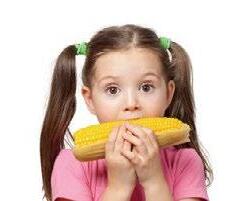
Simple monologues by one of the characters introduce the vocabulary and core structure of the unit in an authentic and communicative context.


Daily Activities
Talking
is your family doing?
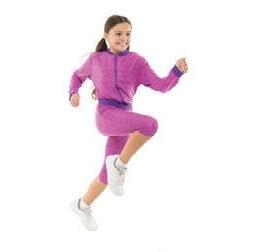




Follow-up activities have students listen to the eight vocabulary items again and find them in the main picture.
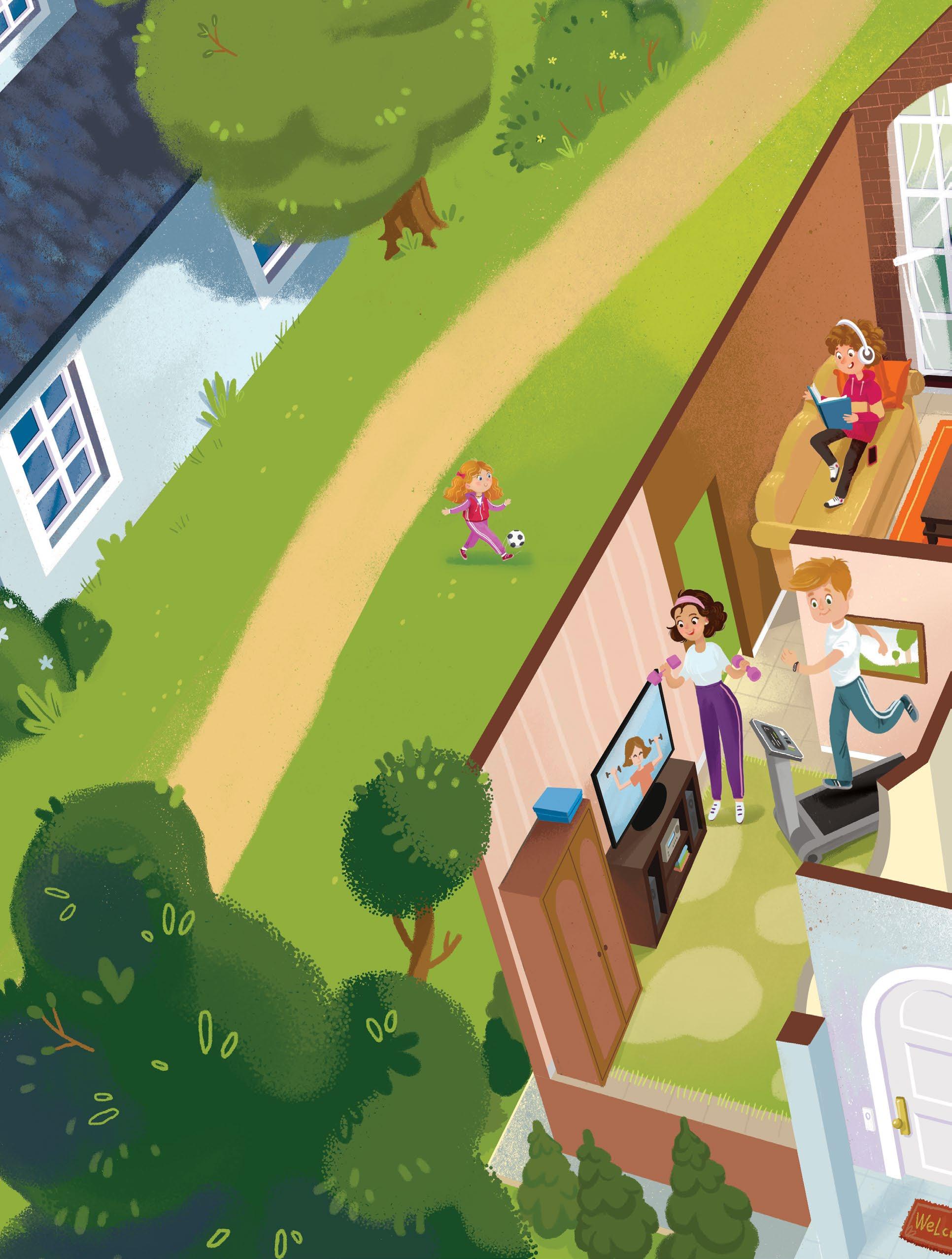



D 091 Sing a song. Turn to page 146.
E Look at the picture. Ask and answer.
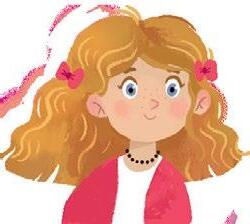
Fun songs provide an exciting opportunity for students to learn the core structure and vocabulary of the unit. Speaking activities reinforce learning objectives. Sample pages from
What is Brian doing? He is reading. What are Mom and Dad doing? They are watching TV

Imagine it is Sunday. Think about your family. What is everyone doing?

Song reviews have students produce the learned vocabulary and structure in memorable songs. Retention is reinforced with a comprehension activity.
A092 Listen and sing. Then, circle and match.
1. Steven is playing soccer / watching TV.
2. Clare is reading a book / playing soccer.
3. Emma is eating dinner / playing soccer
4. Alex is eating dinner / studying French.
5. Brian is reading a book / studying French.
ARead and answer.




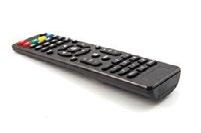
Reading
Short readings present the structure and vocabulary in a new context. As the series progresses, students are faced with longer authentic readings.
Comprehension activities strengthen and confirm the students’ understanding of the new vocabulary structure.
Dear Diary, Alex



Emma is 1 . Brian is 2 .

Mom and Dad are 3 . My friends are 4 . They are happy and excited. I am just in my bedroom. I’ m so bored.
What are they doing? Circle and write.
1. Emma is / are to music.
2. Brian is / are a book.
3. Steven and Clare is / are TV.
4. Alex’s friends is / are soccer.
Sample pages from
A Circle three people in the picture below.
Speaking

B What is everyone doing? Ask and answer.








Preparation activities help students get ready for the speaking task with various activities, such as puzzles, cut-outs, drawing, and coloring activities.
Speaking tasks require students to share information about Part A and allow teachers to monitor students’ comprehension and use of the core structure and vocabulary.
Speaking progression Speaking tasks progress into more collaborative and group-based activities as the series progresses.
Comic-book style stories let students follow the main characters in amusing situations.
A
OK, let’s go! Where’s Brian?

Engaging comics and animations let students practice listening and speaking in a fun and engaging way.

Natural language and situations introduce the unit’s secondary vocabulary set and expansion structure.
Role-play activities let students have fun practicing the language structures.
Listen and repeat. Then, watch.

Now, where is he?
He’s in his bedroom. He’s reading.

B Role-play the story.
Comprehension activities check students’ understanding of the story and focus on the key vocabulary and structure.

Brian, put on your shoes! Let’s go!

Hurry, or we won’t have time for ice cream!


C Read the story again. Then, answer.
is in




2. Who is in the bedroom?




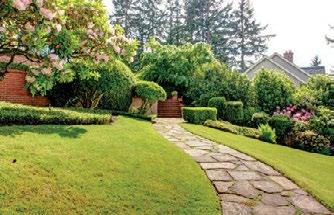







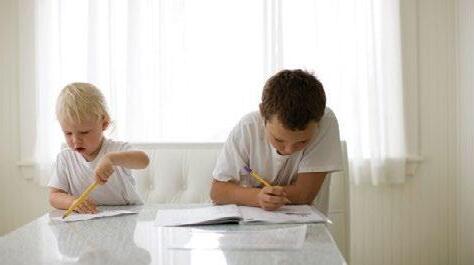



More colorful images introduce the second set of vocabulary items to students. Follow-up vocabulary activities help students recognize the key words. Picture-based substitution drills provide practice using the vocabulary and structure.
Exciting chants reinforce the vocabulary and structure.



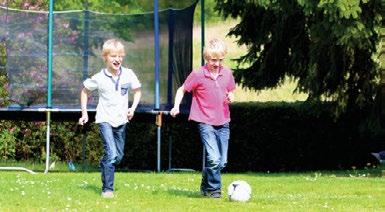
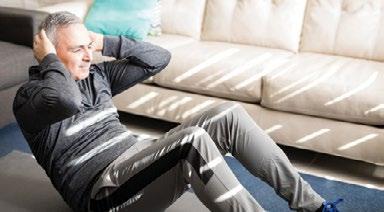










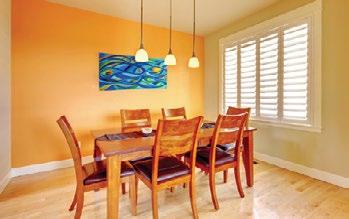



Phonics activities in levels Starter, 1, and 2 build the students’ spelling skills and ability to sound out words.
Writing activities provide extra writing practice and a framework for a short writing project. Writing progression Students begin the series with writing practices that build students’ fine motor skills. They then progress to simple sentence construction. By levels 3-4, students move on to paragraph writing. Finally, levels 5-6 have students plan and write complete essays.

CLIL reading passages connect the unit theme, vocabulary, and structures with an interesting topic. Cross-curricular learning and content language integrated learning (CLIL) are featured in a magazine-style presentation.
CLIL: Science
Robots and Computers
Many people have computers in their house. Computers can do many things! A Listen and read.
Samuel has a special computer in his bedroom. He talks to it. It helps him when he is studying math. He says, “What’s five plus five?” The computer says, “Ten!”
Natalie has a robot in her house. The robot cleans the living room. It cleans the hall and the dining room, too. Natalie doesn’t have to clean. She is playing video games.


Big, colorful images aid comprehension and provide opportunities for expansion activities.

My teacher’s name is Mr. Miller. He has a special computer in the kitchen. It talks to his cell phone. He uses it at the supermarket. His cell phone tells him, “You don’t have fruit.” It also tells him, “You don’t have milk.”
My teacher’s computer is very smart!



Sample pages from
Answer the questions. Circle.
1. Where is Samuel’s computer?
a in the kitchen b in the living room c in the bedroom
2. What is Natalie doing?
a cleaning the living room b playing video games c cleaning the dining room
Listen and circle. Then, answer the questions.
1. Samuel studies / plays with his computer. Is he right? Yes No


3. Mr. Miller’s special computer is in his bedroom / kitchen.
Is he right? Yes No

2. Natalie’s robot cleans the dining room / bathroom. Is she right? Yes No
4. Mr. Miller’s special computer talks to his cell phone / students.
Is she right? Yes No
D What does Natalie’s robot do? Circle and say.





The last activity checks the students’ comprehension of the reading passage. Linked-skills activities with listening comprehension incorporate listening and reading. Students listen and determine whether statements are correct or incorrect. Reading comprehension activities check students’ understanding.


All-new project pages
My House



Project crafts and activities allow students to synthesize their knowledge and comprehension.
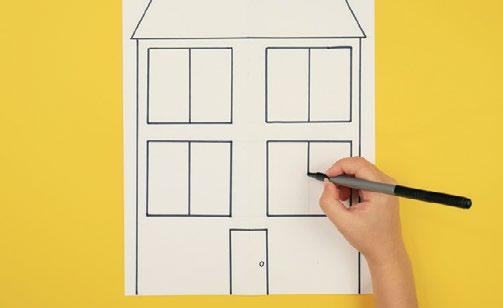


progression

While lower levels contain craft activities and games, middle levels focus on collaborative production such as role-plays, surveys, and posters. Upper levels challenge students to research, discuss, and debate about advanced topics.








Look and play.


Good! One point for Team 1.
Charades

He is eating!

allow students to use the key structures, language, and vocabulary in an interactive and fun way.


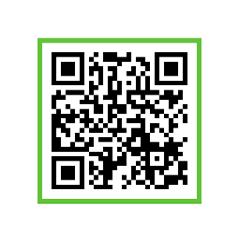

The main illustration introduces the situation of the dialogue in the first activity.
Extended dialogues between the characters introduce the vocabulary and core structure of the unit in an authentic and communicative context.











C 002 Look at the pictures. Then, listen and write the letters.
D Look at the pictures. Ask and answer.

What are you doing tomorrow? I’m doing housework. What is he/she doing on Monday? He/She is golf ing

Speaking activities reinforce learning objectives.
Short readings present the structure and vocabulary in a new context. By levels 5-6, students are faced with longer authentic readings.
A Read.
Hi , Ryan ,
Comprehension activities strengthen and confirm the students’ understanding of the new vocabulary structure and its usage.
Reading
I hope you ’ re having a good day at school. I can ’ t believe it ’ s only Tuesday. What are you doing this week? I have a lot of things to do, but I hope we ’ ll be able to make time to hang out. I ’ m going to gymnastics after school today. My family is doing housework tomorrow , and I ’ m going on a run.
What are you doing on Thursday? I think I ’ m free then.
I ’ m busy this weekend , too. I ’ m having a sleepover on Friday night with Li and Sara. I ’ m checking my homework on Saturday. My brothers are going to help me. After that , we ’ re golfing near the park. Do you want to come?
Let me know. I ’ m writing out my schedule so it ’ ll be easier for you to read.
Jenny ’ s Schedule
Tuesday after school I ’ m going to gymnastics.
Wednesday after school I ’ m going on a run.
Thursday after school Free
Friday night I ’ m having a sleepover with Li and Sara. Saturday I ’ m checking my homework and golfing with my brothers.
I hope we can meet again soon.
Jenny
B Read again and answer.
1. What did Jenny write about? a her favorite activities b her schedule this week c her plans with Ryan
2. What is Jenny doing on Wednesday?
3. What is she doing on Friday night?
4. What is she doing on Saturday?
Speaking
Ask your partner what he or she is doing after school each day next week. Fill in the chart.
Preparation activities help students get ready for the speaking task.

What are you doing on Monday? I’m doing housework.


Copy the activities into the chart below. Now, try to find another classmate who is doing the same thing on each day.
Are you going on a run on Monday? Yes, I am. / No, I’m not.

Speaking tasks require students to share information about Part A and allow teachers to monitor students’ comprehension and use of the core structure and vocabulary.
Speaking progression
Speaking tasks progress into more collaborative and group-based activities as the series progresses.

Listening dictation activities allow students to use their listening and inference skills. While students are listening to the audio track, they can focus on the unit’s secondary vocabulary set and expansion structure.
A
Alex
Nadir
Alex

Engaging animations let students practice listening and speaking in a fun and engaging way.
Listen and write. Then, watch.

Nadir
Alex
Nadir
Swimming has been so much fun today. You are a great swimmer, Nadir!
I love swimming. I want to swim
What are you doing tomorrow? Do you want to go to the ? I need to buy something for my family.
I can’t. I’m busy.
What are you doing?



Alex
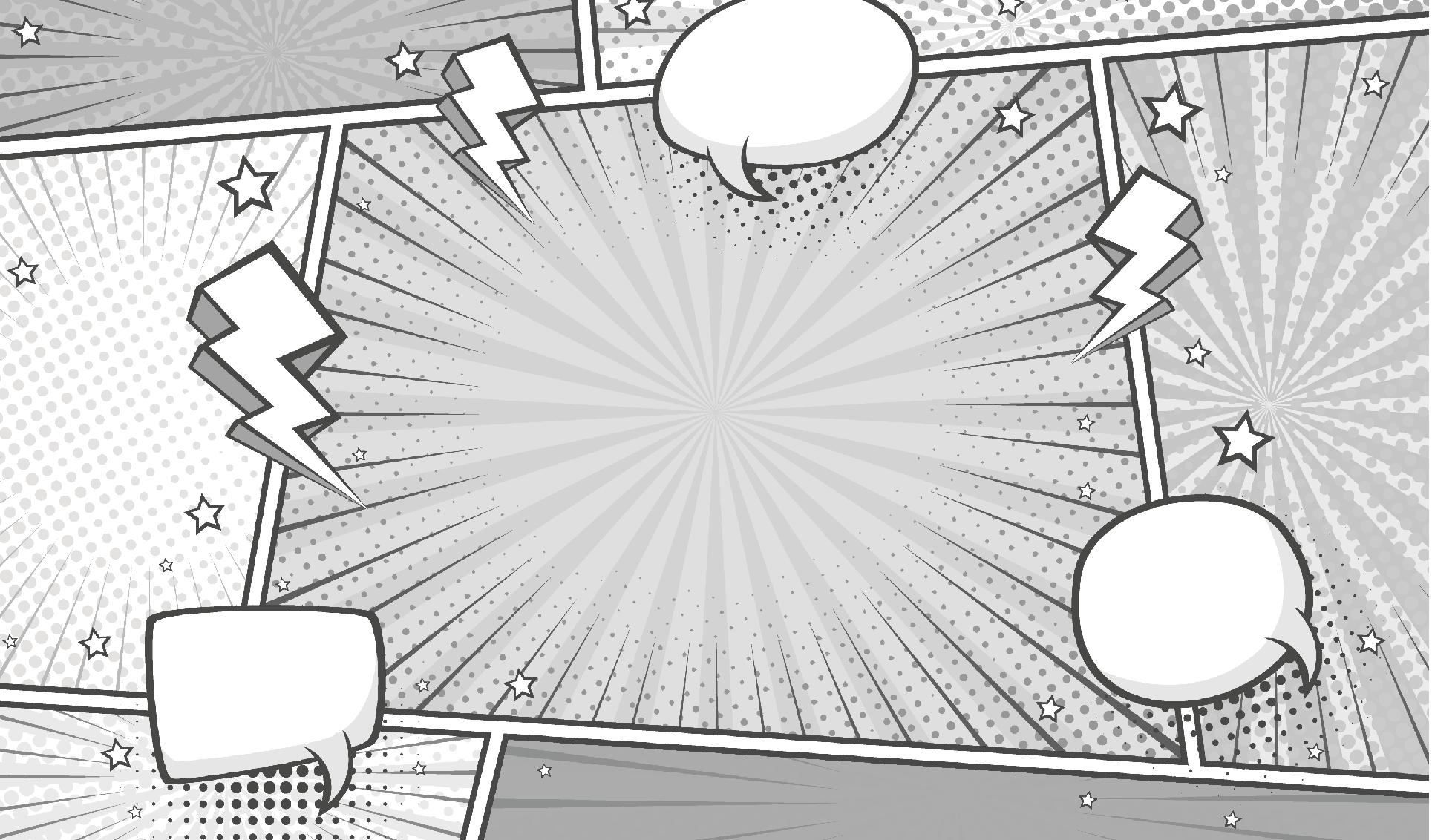
Nadir
Alex

Nadir
I’m helping out Daniel with his homework. He is having trouble in math class.
Oh, right. The math homework this week was really difficult. What about the ?
I’m then, too.
With what?





Role-play activities let students have fun practicing the language structures.
Comprehension activities check students’ understanding of the story and focus on the key vocabulary and structure.
Alex
Nadir
Something really exciting! Tell me, Nadir!

I need to a paper for school.


B Role-play the story.
C Read the story again. Then, answer.
1. What are Alex and Nadir talking about?
a future plans b Alex’s homework c Alex’s paper
2. What does Alex want to do tomorrow?
a go swimming b go to gymnastics c go to the mall
3. Why can’t Nadir hang out with Alex tomorrow?
a He’s bored. b He’s tired. c He’s busy.
4. What does Nadir need to do tomorrow?
a type a paper b buy something c help Daniel out










Listen.



More colorful images introduce the second set of vocabulary items to students.







Follow-up vocabulary activities help students recognize the key words. Picture-based substitution drills provide practice using the vocabulary and structure.

All-new grammar pages
Grammar

A grammar activity outlines the grammar used in the first core structure of the unit and gives students an opportunity to practicewhat they learned.
What do + Simple Present to Ask about Regular Activities
What is he/she doing tomorrow? He’s/She’s doing housework. What are you/they/we doing tomorrow? We’re/They’re going to the dentist.
A Read, circle, and write.
1. What is he / she on Monday? She . (purchase books)
2. What are you / they on the weekend? They . (watch the soccer game)
3. What is / are we tomorrow? We . (go to the mall)
4. What is / are you this week? I . (help out my friend)
5. What is / are David and Judy this Wednesday? They . (type a paper)

A second grammar outlines the grammar used in the expansion structure of the unit and gives students an opportunity to practice what they learned.
6. What are you / he next month? I . (go to the dentist)
Needtofor Obligation
I/We/They need to organize my desk. He/She needs to go to the bike shop.
B Underline and correct the mistakes.
1. They needs to go to the gymnastics.
2. She need to go to the recycling center.
3. We are need to do housework.
4. Ted and Violet needs to go to the mall.
5. My teacher need to checks my homework.
6. I needs to repairing my glasses.
Writing Guide
Writing
Review: A paragraph is a group of sentences about the same topic or idea. It's important to use paragraph format when you write. A paragraph has three parts: a topic sentence, supporting detail sentences, and a conclusion sentence
- states what the paragraph is about - states the main idea - shows why the main idea is true - restates the main idea - summarizes the paragraph
Read the paragraph. Underline the topic sentence and the conclusion sentence. Highlight the supporting detail sentences.
My Plans
I have a lot of things to do this week. I need to type a paper for my English class. I’m not sure when I will do that. On Tuesday and Thursday, I’m going to gymnastics class after school. I need to do housework on Thursday because I am having a sleepover with my friends on Friday. Then, on Saturday, we are going to the mall together. So, I will be pretty busy all week. What are you doing this week?
B Look at the pre-writing chart. Write your plans for next week.

A writing guide teaches students the components of an essay and about different types of essays.

The first writing provides an excerpt of a sample essay that is provided as downloadable material. Students get an idea of what they have to write about and expand their knowledge with an annotation activity.

The pre-writing has students brainstorm ideas and plan their essay.
C Plan and write your own paragraph. Go to page 119 in the workbook.
CLIL reading passages connect the unit theme, vocabulary, and structures with an interesting topic. Cross-curricular learning and content language integrated learning (CLIL) are featured in a magazine-style presentation.


Reading comprehension activities check students’ understanding.
Listening comprehension lets students use their listening skills at an advanced level. The students listen to the questions, which are not given in the book, and choose the correct answers.

Discussion questions let students think critically and organize their ideas on a certain topic.

All-new project pages


Projects and activities in levels 5-6 allow students to focus on advanced speaking. Levels 5-6 contain various types of projects such as discussions, debates, and posters. Each project involves students researching a chosen topic.

Poster projects allow students to collaborate and create posters on a chosen topic. Students practice their speaking skills by giving a short presentation.
Poster
A Preview.
1. Look at the pictures below. What are their jobs? What do they do?
2. What do you think they need to do every day/week? Why?
3. What would their weekly plan look like?



B Read and brainstorm.
Project


- What does that job do?
- What are some things that person has to do every day?
- What are some things that person has to do every week?


Research a certain job. Make a weekly plan.
NOTES
OUT! PLUS STUDENT BOOK 5



C Create a poster.
D Write your own presentation script.
Using speech transition words and phrases allow you to smoothly move from one point to another in your speech.
Starting speech First,... Let’s begin with... I will first cover...
Providing details Also,... In addition,... Furthermore,...
Ending speech Finally,... Lastly,... In conclusion,...
E Present your poster.
F Listen and give feedback.

Classmate’s name : Speaks clearly Pace Engages the audience Understands the topic
What did you like?

Peer review and summary activities give students an opportunity for peer evaluation and allow students to consolidate their learning by reflecting on what they have learned. Students are also given a chance to reflect on their classmates’ ideas. Sample pages from
What can be better?
Picture-based vocabulary activities review the unit vocabulary while consolidating writing skills.
7 UNIT Daily Activities










Awareness-building activities reinforce the key structure.
1. What is Emma doing? She is soccer.
2. What is Brian doing? He is a book.
3. What are you doing, Alex? I am French.
4. What is Lisa doing? She is a snack.
5. Clare and Steven are in the living room. What are they doing? They are TV.



Listening activities are included to ensure students build familiarity with the vocabulary and structure in a range of contexts.





Activities ensure comprehension of the first structure and vocabulary set.
Short listening passages present the unit vocabulary and structure in a different context.
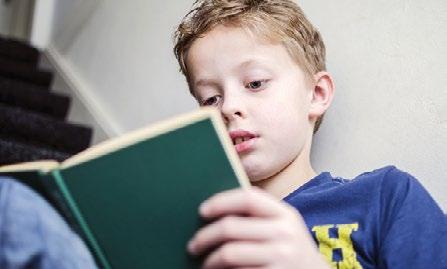





Listening



Listening activities progress from focusing on overall understanding to specific details.
Listening activities build recognition and awareness of grammatical structures.



Writing
A Look, circle, and write.






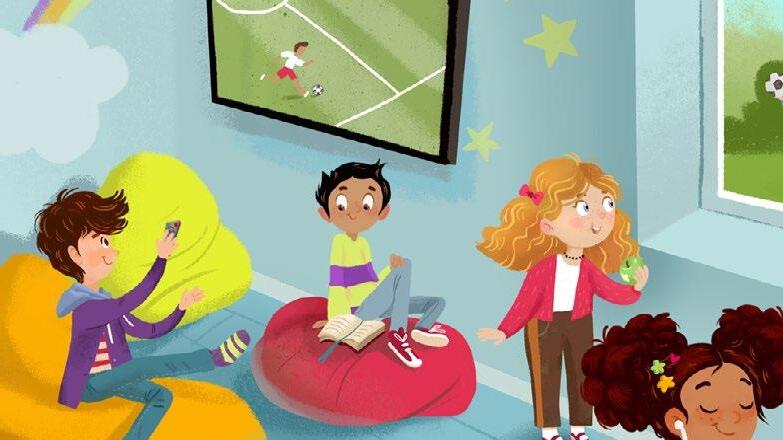


Writing activities build students’ familiarity with the structure of the unit and provide guidance through a wide range of activity types.
Transcription and writing activities have students practice their writing and listening comprehension.
Vocabulary
Games such as word puzzles, crosswords, and word searches help students to reinforce their knowledge of the new vocabulary.
A Look and find.






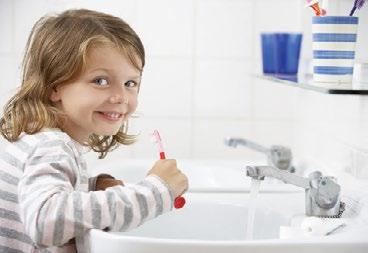

Speaking







1. Where is he?
He’s in the garage / living room.
2. What is he doing?
He’s using the computer / listening to music.
3. Where is she?
She’s in the kitchen / backyard.
4. What is she doing?
She’s reading / eating lunch.
Grammar
Speaking activities are presented through dialogues followed by listening and writing so that students can review their learning.

Grammar activities review and reinforce students’ knowledge of the unit’s grammar points.
CLIL pages mirror and expand on the CLIL themes in the Student Book.
My Day
A 50 Listen. Number the pictures in order.







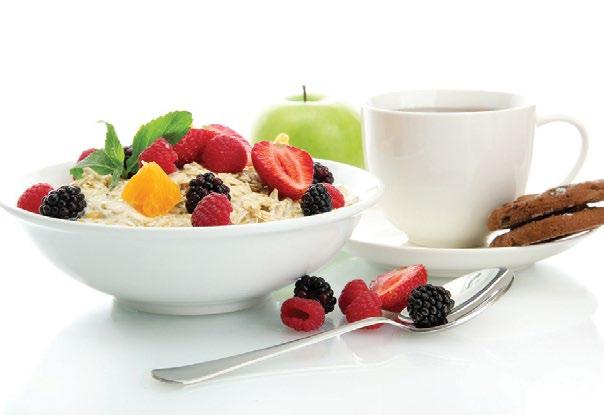
Easy-to-understand activities reinforce students’ understanding of the vocabulary, grammar structures, and CLIL themes of the unit.
B 51 Listen again and check.
1. It is morning. Peter is exercising.
2. Peter is studying at school.
3. Peter is eating breakfast in the kitchen.
C 52 Listen again. Write the activity.

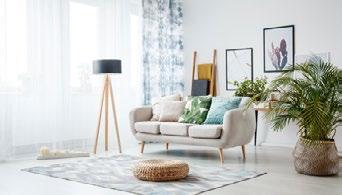

Yes No
4. Peter is watching TV in his bedroom. in the kitchen in the living room at school in the bedroom

Phonics

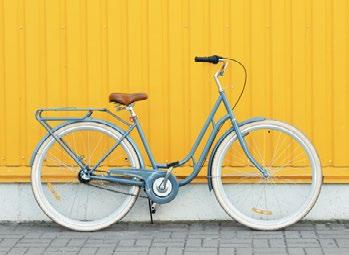


B Circle the long i words.







C Read aloud. Then, color the picture.
1. I ride my bike in the afternoon.
2. I like to fly my green kite.
3. We are in the dining room eating pie.
4. I’m exercising in the hall.
For the portfolio, see page 99.





Additional phonics activities build upon the sounds learned in the Student Book.
Short reading activities build students’ confidence with the target sounds.
Portfolio pages at the back of the Workbook allow students to demonstrate what they have learned with a final output for the unit.
Unit 1 School Things
A Look at page 17 in your student book. What is in your backpack? Draw a picture and color it.
Coloring and drawing activities let students personalize their learning.
B Choose three things. Write about them.
Writing frameworks assist students in creating complete sentences and provide lower-level learners with added confidence.
In my backpack, I have . It is . I have . It is . I have They are (color) (color) (color)
Unit 1 Check Up
Check the words you know.
School Things
backpack pencil pen eraser
lunchbox textbook crayon pencil case
pencil sharpener glue stick ruler paintbrush marker notebook tape stapler
Read and check what you can do.
Speaking
I can name things at school. I can say what I have and what I don’t have.
Listening
I can understand when someone talks about school things. I can understand when people say what they have.
Reading
I can read and understand short passages about school things.
Writing
I can write a few sentences describing the things I have in my backpack.
Phonics
I can make the long i sound.
Check-up sections provide a check-list of the learning objectives for the unit and help students, teachers, and parents track what students have learned.

New features include...
• An increased CEFR level cap: exiting at CEFR B2
• Renewed design and illustrations
• Renewed comics and animations
• 10 units per level
• Dedicated grammar pages
• Enhanced, scaffolded writing curriculum with paragraph and essay writing
• Creative projects, crafts, games, and collaborative activities
HANG OUT! PLUS is a seven-level coursebook series designed specifically for elementary learners of English. Hang Out! Plus includes an accelerated CEFR level structure, expanded content, additional materials, and renewed comics and illustrations. Students will learn by following a family of characters in their daily lives. With vivid illustrations, realistic readings, and engaging comics, students will build their knowledge of high-frequency vocabulary, common grammar structures, and useful expressions. Every unit of Hang Out! Plus has dynamic activities and features, such as engaging stories, comics, CLIL readings, projects, songs, chants, and more to improve reading, writing, listening, and speaking skills.
Features
● Interesting characters and realistic contexts
● Engaging activities covering all four skill areas
● Upgraded and systematic CEFR-based curriculum
● Vividly animated comics
● Enhanced CLIL readings

● Project-based learning
● Teacher’s Guide with extensive classroom notes
● Free downloadable worksheets to expand on lessons
● Interactive whiteboard support and digital content
